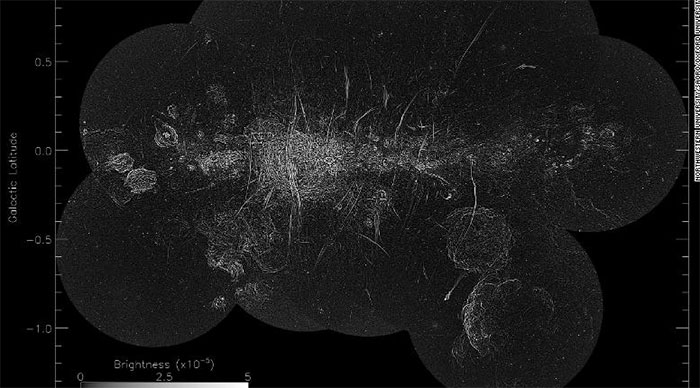Discovered thousands of mysterious strings in the center of the Milky Way
According to a new image from a telescope, at the center of the Milky Way, there are nearly 1,000 mysterious magnetic strings. The pairs and clusters of filaments span nearly 150 light-years and are evenly spaced.
These strange structures are several million years old and come in many different forms. Some strings are like harp strings, waterfalls or even rings around Saturn.
However, so far astronomers have not yet grasped the true nature and origin of the strings, according to CNN.

The image shows that these magnetic filaments exist at the center of the Milky Way as vertical filaments
Farhad Yusef-Zadeh, a professor of physics and astronomy at Northwestern University (USA), first discovered these strings 35 years ago via radio waves. He determined they were made of cosmic ray electrons traveling through a magnetic field at nearly the speed of light.
Now, thanks to the South African Radio Astronomy Observatory's MeerKAT telescope, astronomers have found 10 times more filaments than Yusef-Zadeh's previous discovery.
Over the course of three years, with 20 different observation systems looking towards the Milky Way, located 25,000 light-years from Earth, astronomers have pieced together the details to form a new astronomical picture with strings. this.
"We studied each rope for a long time. Finally got a full view of the countless silk threads. It's like a work of modern art. The pictures are so beautiful and rich. It is the mystery of the strings that makes it more interesting," said Mr. Yusef-Zadeh.
Astronomers think that these filaments are more likely to be related to activity caused by the supermassive black hole at the center of the Milky Way in the past than to the explosions of stars.
The team also identified stronger magnetic fields along the fibers.
As the team works to identify each strand, they're still trying to figure out why the clumps are spaced equally. It is possible that the filaments are connected to the giant spherical structure at the center of the galaxy, as previously discovered by Yusef-Zadeh and his team in 2019.
"We hope to get to the bottom of the matter," he said. "However, a full understanding of complex subjects takes time."
- The center of the Milky Way may contain thousands of black holes
- Discover an X-shaped structure in the center of the Milky Way
- Discovery of the mysterious 'galaxy wheel' near the Milky Way Milky Way
- Discover mysterious radio waves in the Milky Way
- Enjoy the pure Milky Way season
- The mysterious bubble appears between the Milky Way
- Decipher the mysterious fog in the Milky Way
- The mysterious age of the mysterious star
- Close up of weird red skeletons in the Milky Way galaxy
- Mysterious planets have a 'mother' from another galaxy
- Revealing the smell of the Milky Way
- NASA's new discovery of 'interstellar space' of stars in the Milky Way
 Van Allen's belt and evidence that the Apollo 11 mission to the Moon was myth
Van Allen's belt and evidence that the Apollo 11 mission to the Moon was myth The levels of civilization in the universe (Kardashev scale)
The levels of civilization in the universe (Kardashev scale) Today Mars, the sun and the Earth are aligned
Today Mars, the sun and the Earth are aligned The Amazon owner announced a secret plan to build a space base for thousands of people
The Amazon owner announced a secret plan to build a space base for thousands of people